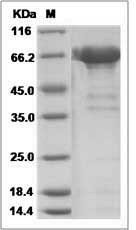-
Product Name
Rhesus DC-SIGN/CD209 (Fc Tag) recombinant protein
- Documents
-
Description
Dendritic cell (DC)-specific intercellular adhesion molecule 3 (ICAM-3) grabbing nonintegrin (DC-SIGN), also known as CD209, is a type II transmembrane protein on DCs with a C-type lectin extracellular domain, is capable of binding ICAM-3 on resting T cells in the secondary lymphoid organs, providing the initial contact between these cells during the establishment of cell-mediated immunity. It is not only a pattern recognition receptor but implicated in immunoregulation of DCs. It has important role in mediating DC adhesion, migration, inflammation, activating primary T cell, triggering immune response and participating in immune escape of pathogens and tumors. DC-SIGN also mediates capture and internalization of viral, bacterial, and fungal pathogens by dendritic cells, such as HIV-1, Ebola virus, cytomegalovirus, Dengue virus, and hepatitis C virus. DC-SIGN is unique in that it regulates adhesion processes, such as DC trafficking and T-cell synapse formation, as well as antigen capture. Moreover, even though several C-type lectins have been shown to bind HIV-1, DC-SIGN does not only capture HIV-1 but also protects it in early endosomes allowing HIV-1 transport by DC to lymphoid tissues, where it enhances trans infection of T cells.
-
Protein short names
CD209; CDSIGN; SIGN-R1; DC-SIGN; CD209A; MGC129965; MGC130443; CIRE; DCSIGN; DC-SIGN1; SIGNR5; CLEC4L
-
Uniprot ID
Q95J96
-
Source/Expression Host
Human Cells
-
Expression Plasmid/cDNA
A DNA sequence encoding the rhesus CD209 (AAK74185.1) (Lys62-Glu381) was expressed with the Fc region of human IgG1 at the N-terminus.
-
Protein Species
Rhesus
-
Molecular weight
The recombinant rhesus CD209 consists of 580 amino acids and predicts a molecular mass of 64.9 kDa.
-
Purity
> 90 % as determined by SDS-PAGE.
-
Validations

Rhesus DC-SIGN / CD209 Protein (Fc Tag)
Related Products / Services
Please note: All products are "FOR RESEARCH USE ONLY AND ARE NOT INTENDED FOR DIAGNOSTIC OR THERAPEUTIC USE"
